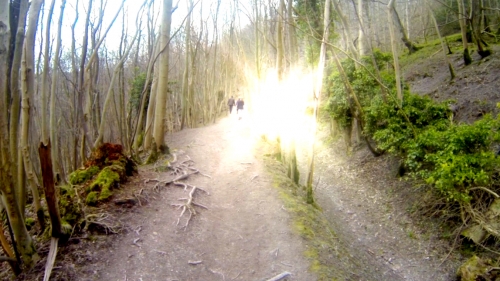About
The aim of the project is to present an immersive digital artwork synthesizing eye level video documentation of participant’s personal walks with simultaneously gathered biomechanical data. Exploring the interpretive qualities of visual effects processes, the team will then work with participants on identifying the most effective way to express the nature and challenge of their personal movement. The resulting films will be presented at visual arts and science venues including learning and public environments, where the life size scale of the work will engage viewers in micro journeys that both interpret clinically accurate data and express individual experience.

Still from Pilot video
Context & Objectives
“Walking is usually about something else – about the walkers character or encounters, about nature or about achievement, sometimes so much so it ceases to be about walking.” [1]
Significant Walks builds upon the research team’s mutual interests in the resonance of walking as an interpretive tool. The team came together in response to Shirley Chubb’s site specific exhibition Thinking Path which took Charles Darwin’s daily ritual of walking the same path in the grounds of his family home as its inspiration.
Through discussion over the past two years the co-applicants came to realise the potential of Chubb’s approach as a means to conceptualise physical problems, and have worked together to identify a new way to investigate how people suffering with lower back pain experience walking. The team will initially use lightweight high definition video cameras to record eye level views of participant’s walks, whilst state of the art inertial sensors will simultaneously monitor posture and movement. This material will form the basis of an immersive projected artwork that synthesises video footage with it’s corresponding stream of kinematic data.
Initially the research will engage with participants from the large but predominantly unrecognized community of people with chronic lower back pain. In particular, the research team recognise that there is a growing generation of individuals who are familiar and confident in the use of digital technologies in every aspect of their lives. This includes a significant proportion of younger people for whom the use of digital technologies offers the opportunity to develop a highly sophisticated ‘presence’ in the world.
It is anticipated that the interdisciplinary and collaborative nature of the project will attract interest from a variety of audiences including those interested in the visual arts as well as patient groups, health professionals and students and interested parties from a range of discipline areas.
Collaborative Research Team
The project team benefits from the inclusion of four discipline areas, sharing expertise in the visual arts, musculoskeletal physiotherapy and biomedical engineering. An essential element of the project is the additional interpretive involvement of participants, with each stage of project development reliant on mutual input to develop and realise the resulting outputs.
The project explores the emerging use of inertial sensors in biomedical sciences, where the small size and portability of devices has allowed the possibility, for the first time, of monitoring people and patients in their natural environments as opposed to the laboratory.[2]
The expertise of the project team will enable participants to explore an innovative approach to expressing their individual engagement with the world. The relationship between the individual and their sense of place is seminal to Chubb’s practice, which explores how our experiential engagement with cultural and social environments shapes our understanding of the world. Significant Walks furthers her interest in synchronic approaches to production, and will build on her methodology of manifesting factual measurements of time, space or site as interpretive expressions of an individual’s engagement with the world.[3] Here the synthesis of video documentation and kinematic data will generate tangible visual representations of the link between external and internal movement, with the significance of each individual’s walk crucial to this process.
The resonance of walking as a metaphor for understanding our individual place in the world is key to this research, both for participants and viewers. Walking is a part of our daily existence, providing opportunities to consider how we interact, navigate and respond to our environment. Given the prevalence of chronic low back pain this experience is compromised for many people and Significant Walks seeks to capture these individual realities by animating quantitative data whilst simultaneously communicating qualitative experience. The resulting immersive artwork will act as a vehicle for both the science of data collection and also the reality of the individual at the core of scientific understanding, reminding us that in considering the experience of others we can better appreciate our own realities.
[1] Solnit, R. Wanderlust, London: Verso (2002) p.132
[2] Ha T.H., Moore A.P., Lee R.Y.W., Saber-Sheikh K., Jones M.P. (2008) Measurement of Spinal Motion Using Inertial Sensors - Comparison of different Computational Methods. 10th International Symposium 3D Analysis of Human Movement. Amsterdam, Netherlands
[3] Chubb, S. (2011) “Location & Intervention: Visual practice enabling a synchronic view if artefacts and sites.” in Dudley, S. Ed. The Thing About Museums: Objects and experience, representation and contestation. London: Routledge. p.199-213